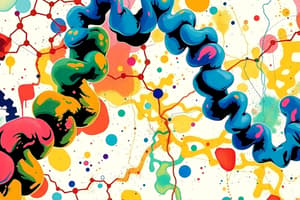Podcast
Questions and Answers
What is the primary structure of a protein?
What is the primary structure of a protein?
- The interactions between different parts of the protein
- The sequence of amino acids that make up the protein (correct)
- The overall conformation of the protein
- The local conformation of the polypeptide chain
What stabilizes the secondary structure of a protein?
What stabilizes the secondary structure of a protein?
- Sequence of amino acids that make up the protein
- Overall conformation of the protein
- Hydrogen bonds between the amino acid residues (correct)
- Interactions between different parts of the protein
Which macromolecules are proteins made up of?
Which macromolecules are proteins made up of?
- Carbohydrates and lipids
- Amino acids and nucleic acids (correct)
- Nucleic acids and proteins
- Amino acids and lipids
What determines the unique three-dimensional structure and function of a protein?
What determines the unique three-dimensional structure and function of a protein?
What are the most common secondary structures in proteins?
What are the most common secondary structures in proteins?
What is biochemistry the study of?
What is biochemistry the study of?
What type of interactions stabilize the structure of the protein?
What type of interactions stabilize the structure of the protein?
Why is the tertiary structure of a protein crucial for its function?
Why is the tertiary structure of a protein crucial for its function?
How do antibodies recognize and neutralize foreign substances?
How do antibodies recognize and neutralize foreign substances?
Why is the three-dimensional structure of a protein important for its stability?
Why is the three-dimensional structure of a protein important for its stability?
What is the function of the active site of an enzyme?
What is the function of the active site of an enzyme?
How does the structure of a protein determine its function?
How does the structure of a protein determine its function?
What can happen if a protein does not have a stable structure?
What can happen if a protein does not have a stable structure?
What is the primary role of understanding the structure of proteins in biochemistry?
What is the primary role of understanding the structure of proteins in biochemistry?
Which type of bonds stabilizes the structure of the protein?
Which type of bonds stabilizes the structure of the protein?
How do enzymes bind with their substrates?
How do enzymes bind with their substrates?
Study Notes
Biochemistry
Biochemistry is the study of the chemical processes that occur within living organisms. It examines the structure and function of biological molecules, such as proteins, carbohydrates, lipids, and nucleic acids. In this article, we will focus on the protein structure, which is an essential aspect of biochemistry.
Protein Structure
Proteins are complex macromolecules that play a crucial role in various biological processes. They are made up of amino acids, which are linked together by peptide bonds. The sequence of amino acids in a protein determines its unique three-dimensional structure and function.
There are three main levels of protein structure: primary, secondary, and tertiary.
- Primary structure: The primary structure of a protein is the sequence of amino acids that make up the protein. This sequence is determined by the genetic code, which is encoded in DNA.
- Secondary structure: The secondary structure of a protein is the local conformation of the polypeptide chain. This conformation is stabilized by hydrogen bonds between the amino acid residues. The most common secondary structures are alpha helices and beta sheets.
- Tertiary structure: The tertiary structure of a protein is the overall conformation of the protein, which is determined by the interactions between different parts of the protein. This structure is stabilized by non-covalent interactions, such as hydrogen bonds, ionic bonds, and van der Waals forces.
The tertiary structure of a protein is crucial for its function. Enzymes, for example, have a specific three-dimensional structure that allows them to bind to their substrates and catalyze chemical reactions. Similarly, antibodies have a specific structure that allows them to recognize and neutralize foreign substances, such as viruses and bacteria.
Protein Structure and Function
The structure of a protein determines its function. For example, enzymes have a specific three-dimensional structure that allows them to catalyze specific chemical reactions. The active site of an enzyme, where the substrate binds, is a specific region of the enzyme that is shaped to fit the substrate. Similarly, antibodies have a specific structure that allows them to recognize and neutralize specific antigens.
The three-dimensional structure of a protein is also important for its stability. Proteins that do not have a stable structure can aggregate and cause diseases, such as Alzheimer's and Parkinson's diseases.
Conclusion
Protein structure is a crucial aspect of biochemistry. The structure of a protein determines its function and stability. Understanding the structure of proteins is essential for understanding their function and for developing new drugs and therapies. Further research in this area will undoubtedly lead to new discoveries and advances in the field of biochemistry
Studying That Suits You
Use AI to generate personalized quizzes and flashcards to suit your learning preferences.
Description
Explore the essential aspects of protein structure in biochemistry, including the primary, secondary, and tertiary levels. Understand how the sequence of amino acids determines the unique three-dimensional structure and function of proteins, and how this structure is vital for their biological processes and stability.




